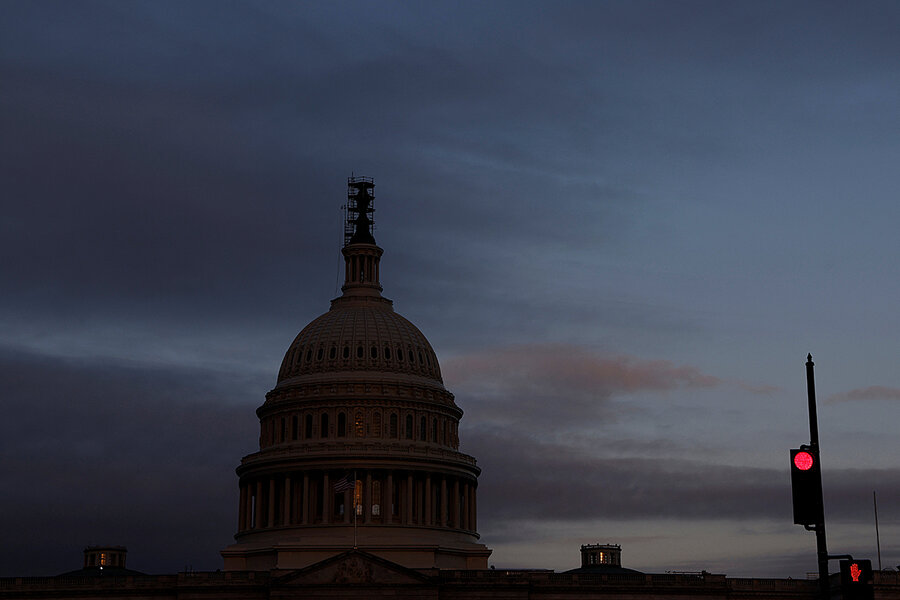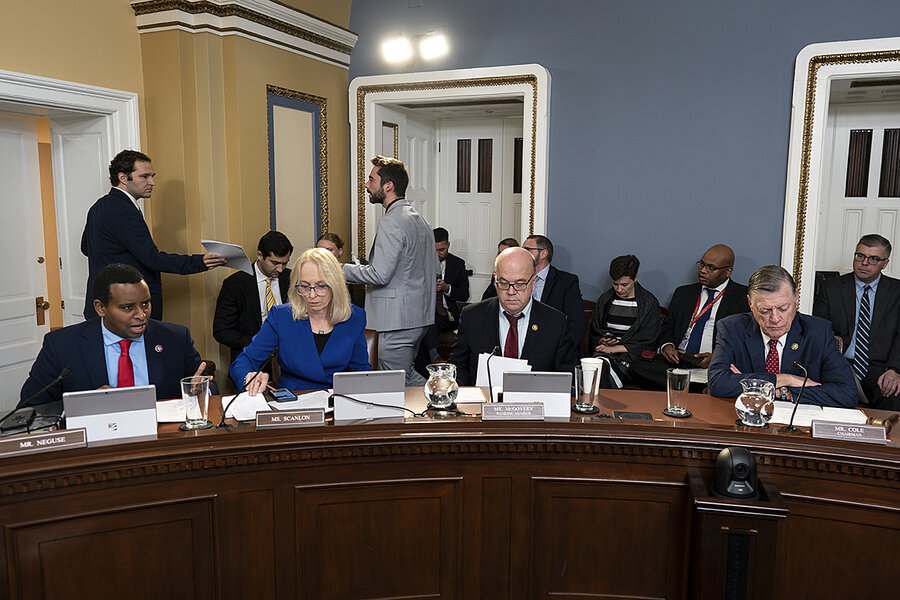Government shutdown: How did we get here, and what could it mean?
Loading...
| Washington
Like a stone thrown into water, a government shutdown initiated in Washington will ripple out across America. Unless Congress can agree to an 11th-hour stopgap funding measure, the government will run out of money at 12:01 a.m. on Sunday, affecting millions of government employees and the citizens their departments serve.
Air travel, national parks, and some food assistance programs are among the things that would be affected. But not every government activity will stop. Social Security checks, Medicare, and Veterans Affairs benefits will still be distributed, for example.
Why We Wrote This
The start of a new fiscal year is a time to hash out budget priorities. But those seeking to exert maximum leverage sometimes undermine the whole process – including their own goals.
It didn’t have to be this way. Everyone knew the government would run out of money on Sept. 30. But in recent years, “Congress has gotten used to not getting its business done on time,” says Oklahoma Republican Tom Cole of Oklahoma, facing his fourth shutdown as a congressman.
While there’s plenty of partisan blame, the underlying fact is that Washington’s budget process is broken. Shutdowns have become showdowns, a last-ditch effort to underscore party objectives and spending priorities. But they rarely achieve their political objectives, instead gumming up the works, hurting citizens, and costing taxpayers.
“The tactic doesn’t work,” says Representative Cole. “I don’t see any upside.”
Like a stone thrown into water, a government shutdown initiated in Washington will ripple out across America.
Unless the House and Senate can agree to an 11th-hour stopgap funding measure, the government will run out of money at 12:01 a.m. on Sunday, affecting millions of government employees and the citizens their departments serve.
While not every government activity would stop, there would be significant disruptions, particularly if a shutdown lasts for more than a few days.
Why We Wrote This
The start of a new fiscal year is a time to hash out budget priorities. But those seeking to exert maximum leverage sometimes undermine the whole process – including their own goals.
Social Security checks, Medicare, and Veterans Affairs benefits will still be distributed in the case of a shutdown, and Medicaid has funding to keep it operating for three months. Still, certain operations within these necessary services will be affected. Individual states, which administer Social Security claims, will have to determine if they have the funds to pay those employees during a shutdown. The issuing of replacement Medicare cards will be paused, regional Veterans Affairs offices will close, and there will be no grounds maintenance at national veterans cemeteries.
The Supplemental Nutrition Assistance Program (or SNAP) has enough funds to continue serving 40 million Americans at least through October. But if the shutdown were to continue beyond that, there would be “serious consequences,” Agriculture Secretary Tom Vilsack said earlier this week. He estimated he could keep WIC, the supplemental food program for women, infants and children that serves more than 6 million Americans each month, open for a day or two with a contingency fund. Some states may have their own WIC fund reserves, but if there is a shutdown, says Mr. Vilsack, “WIC shuts down.”
Americans’ air travel could also be affected. Air traffic controllers are expected to be on the job without pay, but security lines could slow or stall if Transportation Safety Administration workers call in sick to protest working without an active income, as they did during the last government shutdown in 2019.
The shutdown would even affect panda goodbye parties, as some Washington residents decry on social media. In the absence of government funding, all Smithsonian institutions – including the National History Museum, the National Portrait Gallery, and the National Zoo will close. That includes a panda cam and sendoff soirees that have been planned for the zoo’s three pandas before they return to China in early December.
The percentage of federal employees who will be furloughed or asked to work without pay varies by department. During the most recent shutdown in 2018-19, more than one-third of the 2.2 million federal workers were affected. But after the passage of the Government Employee Fair Treatment Act amid the 2019 shutdown, any furloughed federal employee who is required to work is guaranteed back pay. Still, this postponement of pay could affect workers’ ability to pay rent and other expenses.
While there’s plenty of partisan blame to go around, the underlying fact is that Washington’s budget process is broken – and has been for years. Shutdowns have become showdowns, a last-ditch effort to underscore party objectives and spending priorities. While sometimes nudging Washington toward fiscal restraint, in recent decades shutdowns have mainly gummed up the works, hurt American citizens, and cost taxpayers.
Obamacare is still here after Republicans shut down the government in 2013 to get rid of it. DACA, the program that would defer deportations for children of unauthorized immigrants, has still not been enacted after Democrats shut down the government in 2017. And the border wall is still only partially built despite a 2018 GOP shutdown over that issue.
“The tactic doesn’t work,” said Oklahoma Republican and Rules Committee chair Tom Cole, facing his fourth shutdown as a congressman. “I don’t see any upside.”
A familiar pattern
It didn’t have to be this way.
Everyone knew the government would run out of money on Sept. 30. But in recent years, “Congress has gotten used to not getting its business done on time,” says Representative Cole.
Indeed, it’s settled into a familiar pattern. First, Congress crashes through the main deadline at the end of the fiscal year. Then it passes a stopgap funding measure to keep the government functioning another two or three months. When that deadline looms, it puts all budget priorities into one gigantic bill, called an omnibus. At the 11th hour, everyone gets to vote yes or no on the entire package – likely without having time to read the whole bill.
House conservatives wanted it to be different this year. They wanted to go back to the way it used to be done: 12 different bills for 12 different parts of government, with time to read and consider each one individually, and debate specific programs and priorities. No omnibus.
But that process got stalled amid intra-GOP squabbling over how much to cut government spending amid record national debt. Some conservatives were aggrieved by a compromise Speaker McCarthy made with Democrats earlier this year to avoid a national default. They shut down the floor this summer in protest. Frustration at these members – who are now requesting lengthy debates after prohibiting action for months – was palpable in the halls of Congress this week.
“Those very same members who didn’t want to take votes in June and July are the very same members who are demanding votes in September,” says North Carolina Republican Congressman Patrick McHenry, chair of the Financial Services Committee and a key McCarthy ally. “That slowed down the whole process to build a consensus to produce bills.”
The renegades later blocked votes on appropriations bills, but Mr. McCarthy still let everyone go home for a 7-week summer recess. Now House Republicans have passed only four of the 12 bills – none of which are likely to be approved by the Democrat-run Senate.
Nor are the House and Senate anywhere close to agreeing on a stopgap measure, known in Washington-speak as a continuing resolution or “CR”, to keep the government running while they finish that process. The House tied theirs to providing emergency funding to bolster border security, with illegal crossings at record highs. Senate Democrats don’t like that. Meanwhile, the bipartisan Senate deal includes Ukraine aid – a dealbreaker for many House Republicans.
In a Friday vote, the House CR was torpedoed by 21 Republicans. That reduces any leverage Mr. McCarthy may have had to push the Senate to include more border provisions. The soonest the Senate could advance their CR would be Saturday morning. Even once it passed, the two chambers would have to bridge their differences.
Democrats were already blaming the GOP for the impending shutdown, and turning it into a campaign issue. New York Congressman Mike Lawler, a freshman Republican who just won a very competitive race, says Democrats have already started spending millions of dollars in his district – even though he’s against the shutdown.
The standoff is also likely to hurt whatever bipartisan goodwill remains in Congress. In the House, Democrats and even some moderate Republicans are frustrated with Speaker McCarthy for letting himself be held hostage by a handful of conservative renegades.
“It’s the same movie, with the same ending and we all have to sit through the credits,” says Rep. Dean Phillips, a Minnesota Democrat and member of the bipartisan Problem Solvers Caucus. Last week, the group’s 64 members endorsed a bipartisan framework for resolving the standoff. “It seems to me that the speaker feels he has to walk down this dead end, even though he knows it’s a dead end, only to then walk back to an intersection.”
Eventually, a resolution involving both parties
Given that Republicans control the House and Democrats the Senate and the White House, the eventual solution must be bipartisan.
And both sides are blaming the other for not recognizing that.
Rep. Pete Aguilar of California, who chairs the Democratic caucus in the House, called the Republicans’ proposed border security measures “fantasy land.”
Rep. Dusty Johnson, a South Dakota Republican who helped broker the House CR with border security provisions, faults Senate Majority Leader Chuck Schumer of New York. Senator Schumer is showing “shocking little interest” in understanding the “needs” of House Republicans, he says.
“He continues to think he’s operating in a world of one-party government where the House is going to go along with the Senate’s plans,” adds Representative Johnson. “This House will not go along with that Senate’s plans.”
Eventually, House and Senate leaders will have to agree on a CR. This could mean the Senate adding some border security funding, which Texas Sen. John Cornyn this week called a “golden opportunity.” Support in the House will likely come from a bipartisan majority, as it did with the debt-ceiling deal, meaning the Ukraine aid provision would not be a dealbreaker.
Once that happens, Speaker McCarthy will be left to pick up the pieces and try to get the remaining eight appropriations bills passed before the CR runs out.
GOP Rep. Tim Burchett, a fiscal conservative from Tennessee, says that the Sept. 30 deadline is no mystery. The GOP could have made it by more methodically pursuing their goal of passing individual spending bills as they have this week.
Whimsically, he quotes a Democratic colleague from his days in the Tennessee legislature: “If we went a little slower, we would have gotten there a little faster.”










